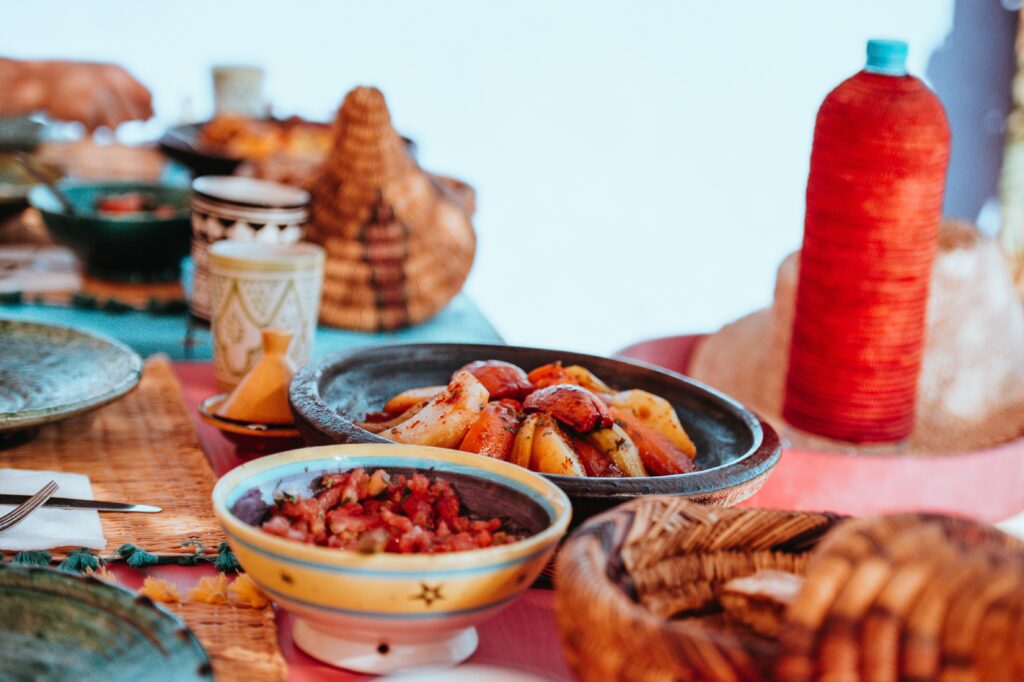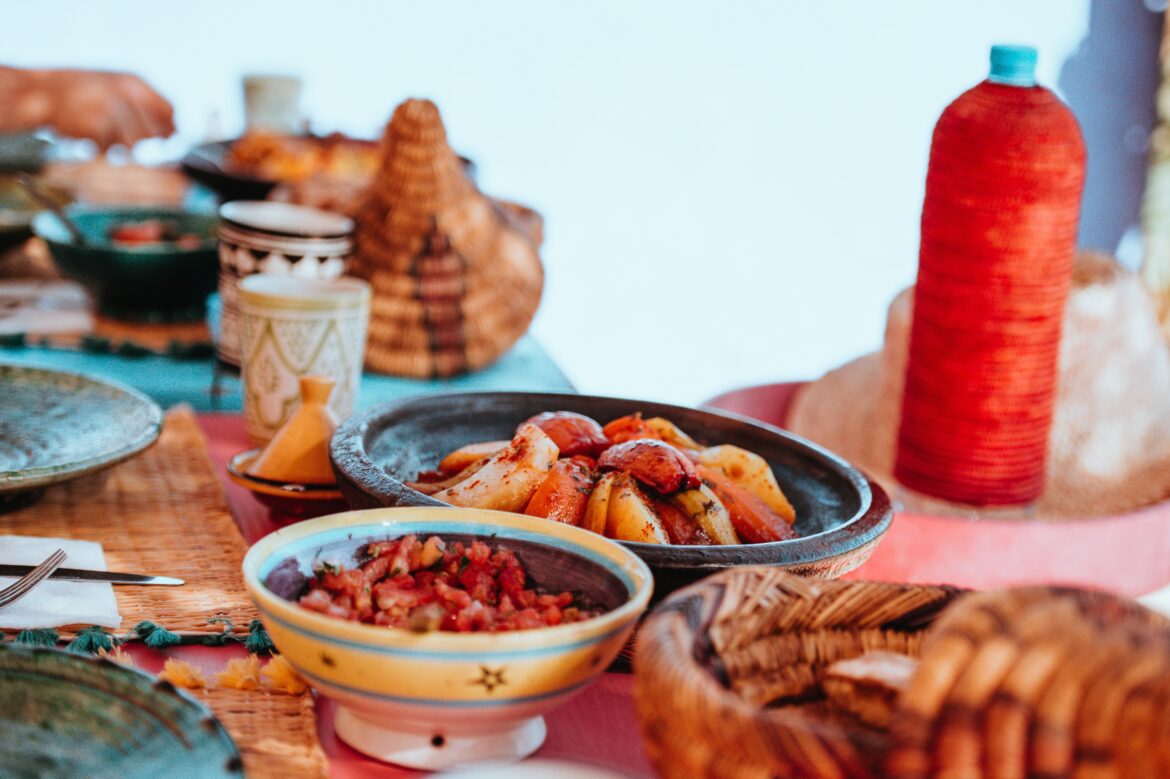Introduction
Nestled in the heart of North Africa, Morocco is a land of rich cultural tapestry, breathtaking landscapes, and, perhaps most notably, an exquisite culinary tradition. As December paints the Atlas Mountains with a cool breeze, locals and visitors alike gather around the hearth to savor the warmth of traditional Moroccan tagines. Embark on a culinary journey through the enchanting Tagine Tales of Morocco, where hearty stews become a celebration of flavors, community, and the unique charm of the Atlas Mountains.
Picture the Atlas Mountains in December, a time when the air is crisp, and the landscape takes on a serene beauty. Small villages with their terracotta-hued houses dot the mountainsides, creating a picturesque backdrop for the culinary traditions that have been passed down through generations. In this setting, the tagine—a conical clay pot with a distinctively domed lid—takes center stage, transforming simple ingredients into complex, aromatic masterpieces.

The Tagine Tradition
Moroccan tagines are more than just a method of cooking; they are a cultural emblem, a symbol of hospitality and togetherness. The Tagine Tradition in Morocco is a culinary art deeply rooted in history and cultural significance. The tagine itself is more than just a cooking vessel; it is a symbol of communal dining, familial bonds, and the meticulous preparation of flavorful dishes. Traditionally crafted from clay, the tagine’s distinctive conical shape and tight-fitting lid play a crucial role in the slow-cooking process that defines Moroccan cuisine.
Slow-cooking over a charcoal brazier allows the tagine to create a harmonious symphony of flavors. The gradual infusion of spices and seasonings transforms simple ingredients into complex, aromatic masterpieces. The conical lid captures and condenses the fragrant steam, ensuring that the essence of each carefully curated component is absorbed into the dish, resulting in a culinary experience that is both comforting and robust. Beyond its practicality, the tagine represents a ritual of togetherness. Moroccan households, whether in bustling cities or remote villages, often use tagines to prepare meals for special occasions or to welcome guests. The process of preparing and sharing a tagine is a labor of love, with the slow-cooking method allowing flavors to meld and intensify, creating a dish that tells a story of tradition and heritage.
The Tagine Tradition is also an embodiment of resourcefulness. The conical shape of the tagine facilitates condensation, enabling the preservation of precious moisture in a region where water scarcity is a consideration. This age-old method of cooking has been passed down through generations, preserving the authenticity of Moroccan culinary heritage. Each tagine is a canvas for creativity, offering a myriad of possibilities for combinations of meats, vegetables, fruits, and aromatic spices. The tagine tradition extends beyond the kitchen, reaching into the vibrant markets where spices are sourced and shared, creating a connection between the land, the people, and the flavors that define Moroccan cuisine.
In summary, the Tagine Tradition is a celebration of more than just food; it is a cultural journey that encapsulates the spirit of Morocco. From the slow-cooking process that enriches flavors to the communal act of sharing around the table, the tagine tradition invites everyone to partake in an immersive experience where the senses are awakened, and the heart of Moroccan hospitality is revealed.
Tagine Tales
December in the Atlas Mountains is a time when tagines tell stories. One might encounter the savory and sweet dance of chicken with apricots and almonds, a dish that reflects Morocco’s historical ties to the Silk Road. Alternatively, the lamb and prune tagine, with its perfect balance of sweetness and earthiness, is a culinary ode to the region’s agricultural abundance. Tagine Tales in Morocco weave a rich narrative of culinary exploration and cultural celebration, particularly during the enchanting winter month of December in the Atlas Mountains. Beyond being a mere cooking technique, Tagine Tales represent a living tradition, a story told through the fragrant steam, melding flavors, and communal gatherings.
At the heart of Tagine Tales are the diverse stories encapsulated in each savory dish. As locals and visitors alike gather around low tables, the tagine becomes a vessel for the tales of Morocco’s history, its geographical diversity, and the intricate blend of Berber, Arab, and Mediterranean influences. These tales unfold as the aromatic stews simmer to perfection, creating a sensory journey that mirrors the captivating landscapes of the Atlas Mountains. December’s Tagine Tales often spotlight seasonal ingredients, emphasizing the connection between the cuisine and the natural abundance of the region. Whether it’s the sweetness of dried fruits like apricots and prunes or the earthiness of root vegetables, each ingredient contributes to a story that reflects Morocco’s agricultural richness and culinary ingenuity.
Beyond the ingredients, Tagine Tales echo the cultural rituals embedded in Moroccan dining. Families and friends come together to share not just a meal but an experience. The act of dining becomes a communal celebration, where the tagine takes center stage as a catalyst for conversation, laughter, and the strengthening of social bonds. The slow-cooking process further enhances the sense of anticipation, turning the dining experience into a shared adventure.
Tagine Tales are also a testament to the artistry of Moroccan spice blending. The meticulous use of cumin, coriander, cinnamon, and saffron creates a symphony of flavors, transforming each dish into a masterpiece that resonates with the essence of Moroccan hospitality. The spice markets in local souks become the vibrant settings where Tagine Tales find their ingredients, inviting both locals and travelers to engage in the sensory exploration of colors, scents, and tastes. As the December chill graces the Atlas Mountains, Tagine Tales offer a warm and inviting refuge. The tales are not only about the flavors but also the ambience—crackling fires, the scent of spices wafting through the air, and the camaraderie of shared moments. Tagine Tales are an invitation to partake in a cultural journey, where the warmth of the tagine extends beyond the confines of the clay pot, creating lasting memories and a profound appreciation for Morocco’s culinary heritage.
Watch this Video to Learn about Moroccas Tagine Recipe
The Essential Spices
Moroccan cuisine is renowned for its masterful use of spices, and the tagine is no exception. Cumin, coriander, cinnamon, ginger, and saffron infuse each dish with a symphony of flavors. The spice markets in local souks burst with vibrant colors and intoxicating aromas, offering a sensory journey that parallels the culinary adventure.
December’s bounty in the Atlas Mountains includes seasonal vegetables like carrots, turnips, and sweet potatoes, complementing the richness of meats such as lamb, chicken, or beef. Olive groves dot the landscape, providing the essential olive oil that imparts a distinctive depth to tagine preparations. Fresh herbs like cilantro and parsley add a final flourish, creating a kaleidoscope of colors and textures.
The Ritual of Sharing
In Morocco, dining is an experience meant to be shared, and the tagine ritual is no exception. Families and friends gather around low tables, sharing stories and laughter as they dip into communal tagines. The traditional practice of eating with one’s hands fosters a sense of connection and community, making the dining experience as memorable as the dishes themselves.
Beyond Tagines: Moroccan Accompaniments
No Tagine Tales journey is complete without exploring the array of accompaniments that elevate the meal. Fluffy couscous, delicate flatbreads, and vibrant salads featuring tomatoes, cucumbers, and olives add a delightful contrast to the hearty tagine stews. Mint tea, with its sweet and refreshing notes, serves as the perfect beverage to cleanse the palate and extend the warmth of the meal.
Conclusion
As December wraps the Atlas Mountains in a gentle chill, the Tagine Tales of Morocco come alive, offering a taste of the country’s rich culinary heritage. Beyond the delicious aromas and flavors, the tagine embodies the spirit of Moroccan hospitality—a warm invitation to gather, share, and savor the simple joys of life. Explore the enchanting world of Tagine Tales, where every simmering pot tells a story, and every bite is a journey through the cultural and culinary landscapes of Morocco.
Learn More
- Greek Islands
- Italian Islands
- Global Food Videos
- Fire Your Boss
- Job Liberation
- Retire Early
- Do What You Love Stories


